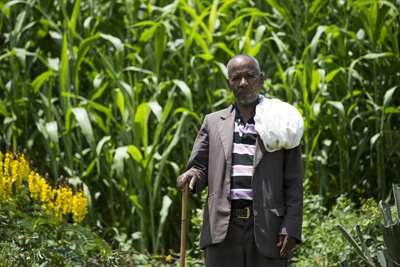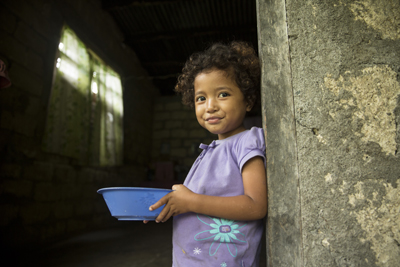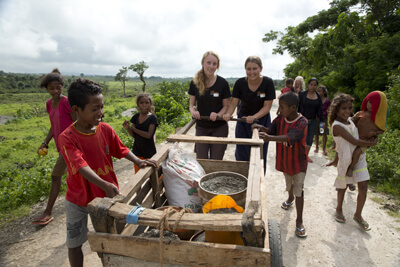
DAVID ADAMS reports on how the 40 Hour Famine has helped change the fight against extreme poverty…
It’s become a “rite of passage” for young Australians – going without food for 40 hours to raise funds for projects aiding the world’s poorest people. And this year is no different with thousands of young Australians expected to go hungry for the cause this weekend.
This month marks the 40th anniversary of the World Vision 40 Hour Famine, which has over the past four decades been responsible for Australians raising some $200 million to help millions who live in poverty in a long list of nations including everywhere from Ethiopia to East Timor and Bangladesh.
|
|
|
MAKING A DIFFERENCE: Top – Abebe Aregaw. 55, lost his childhood friend during the Ethiopian famine in 1984. After the initial emergency food distributions, World Vision provided Abebe with farming tools and seeds and he now has half a hectare of fruit trees; Middle – Children in Timor Leste suffer a high rate of malnutrition but World Vision helps by providing training so they have a regular source of food; and, Bottom – 2015 Youth ambassadors Isobel and Clea help collect rocks to mix cement for a community building a well in East Timor. PICTURES: Ilana Rose/World Vision; Lucy Aulich/World Vision;Lucy Aulich/World Vision
HOW THE 40 HOUR FAMINE CHANGED MY LIFEI first came across the 40 Hour Famine as a secondary school student in the mid-1980s and it’s impact was immediate.The world had recently witnessed images of people dying in the Ethiopian famine of 1984 and the global response that had followed through such initiatives as Live Aid. The 40 Hour Famine was an immediate way that I, as a student, could support the cause of helping those in poverty in a very real way.Thanks to an essay competition World Vision then ran (which has evolved into what is now known as the ‘Ambassadors’ program), I was fortunate enough to go to Canberra several times during the mid to late 1980s on study tours to find out more about how World Vision – and Australia as a whole – was addressing the issue of global poverty and to meet with advocates and those working in the area as well as political leaders such as then Prime Minister Bob Hawke and Governor-General Sir Ninian Stephen to talk about the issue.This culminated in a trip to Africa in 1987 where I saw firsthand how the work of organisations like World Vision was making a difference in countries including Kenya, Tanzania and Zimbabwe.Back in Australia, one of the most interesting 40 Hour Famine-related events I was involved in was in 1989 when I, along with family and friends, were among 40 young people who rode Melbourne’s rail system for 40 sleepless – and rather hungry – hours before tucking into hamburgers before the news cameras at Flinders Street Station.The 40 Hour Famine remains a powerful way to gain some idea of the hunger so many people around the world still experience today. And while massive inroads have been made in the global battle against poverty – which the number of people living in extreme poverty declining from 1.9 billion in 1990 to 836 million – the need to fight for change remains.The 40 Hour Famine is one concrete way we can help. It helped open my eyes to what was happening around the world in a new way and showed how I could be involved in being part of the solution. Beware, though, that taking part may change your life in significant ways as it did mine (and don’t forget the barley sugars!).– DAVID ADAMS |
Tim Costello, chief executive of World Vision Australia, says the event has been extraordinary not just for the money it’s raised but, perhaps more importantly, for the fact it’s connected thousands of young Australians with the issue of poverty around the world.
“It’s been the entry point for now three generations of people…and has actually brought home the reality that we are blessed…(and) we can do something to save other lives – (of people) who did nothing wrong except they were born in the wrong place…”
Mr Costello first did the 40 Hour Famine while studying law at Monash University in 1975 after he was invited to do so by his brother, now former Federal Treasurer Peter Costello.
He says that over the past 40 years, the 40 Hour Famine has “woven itself into the fabric of Australian life.”
“I think it’s become a rite of passage for many kids – half the schools in Australia do it and when you think the rites of passage have morphed into Schoolies Week and things parents are really worried about, this is a really healthy rite of passage to say, even as a young person, ‘Before I’ve got a job, I can do something morally serious, I can be proud that I not just participated but raised money, gave hope, saved lives’.”
While the concept of a 40 Hour Famine started in Victoria in 1975, the idea has since spread around the world. As many as 400,000 people in 21 countries, including Canada and Hong Kong, now take part, albeit with other countries adopting shorter “famine” period than the 40 hours undertaken in Australia.
“Australians are the toughest and we started it…” says Mr Costello. “The fact it’s worked in other cultures just shows there’s this universal cultural perspective of really, a sense of gratitude. What the 40 Hour Famine really brings home to you is I’m grateful for who I am.”
He adds that the concept of 40 hours came from the Bible. “Jesus fasted 40 hours in the desert, Moses (had) 40 years in the wilderness, and it also does parallel with the fact that 800 million people went to bed hungry last night, every night, who have often gone without sufficient (food) coverage for 40 hours.
“So it was really getting out of our model of just always having enough food to really identify in our body with what that would be like…Literally feeling it in our body is different to just knowing it in your mind, to just knowing it conceptually…”
Mr Costello says it is a “very confronting notion” to realise that while we are “feasting” and spending billions on dieting programs, there are “mothers thinking that my child is not going to get enough calories to survive today”.
He says the 40 Hour Famine is about empowering people to realise that they can do something about it. “And literally the 40 Hour Famine has saved tens of thousands of lives and given hope.”
The concept of the 40 Hour Famine has evolved somewhat since it began with people now giving up a range of different things – including such things as the use of a limb or using social media – alongside food.
“You can give up furniture, you can give up technology, you can give up speaking,” Mr Costello says. ‘I always sponsored my three kids to be silent for 40 hours. That was worth the money…And I paid generously.”
Part of the success of the event has also been due to the high profile support its received from people such as ex-Prime Ministers like Bob Hawke and Malcolm Fraser and celebrities including everyone from Bert Newton and Kylie Minogue to Hugh Jackman and Craig McLachlan. It’s also been featured in numerous locally produced TV shows, including Neighbours, Heartbreak High and Big Brother as well as telethons.
The organisation has also run various incarnations of a ‘youth ambassadors’ program in conjunction with the famine which has recruited young people to advocate for the cause of poverty by exposing them to the work World Vision is doing to help the poor around the world.
Mr Costello believes the concept of the 40 Hour Famine hasn’t reached the end of its life yet. “While there’s world hunger, I think the direct connection morally and emotionally is still so powerful…” he says. “I think the 40 Hour Famine is all about perspective – that what we experience is normal. No, it’s not. There are people who were just born on the wrong latitude who aren’t blessed and struggle and that perspective is, I think, able to see it carry on another 40 years.”







